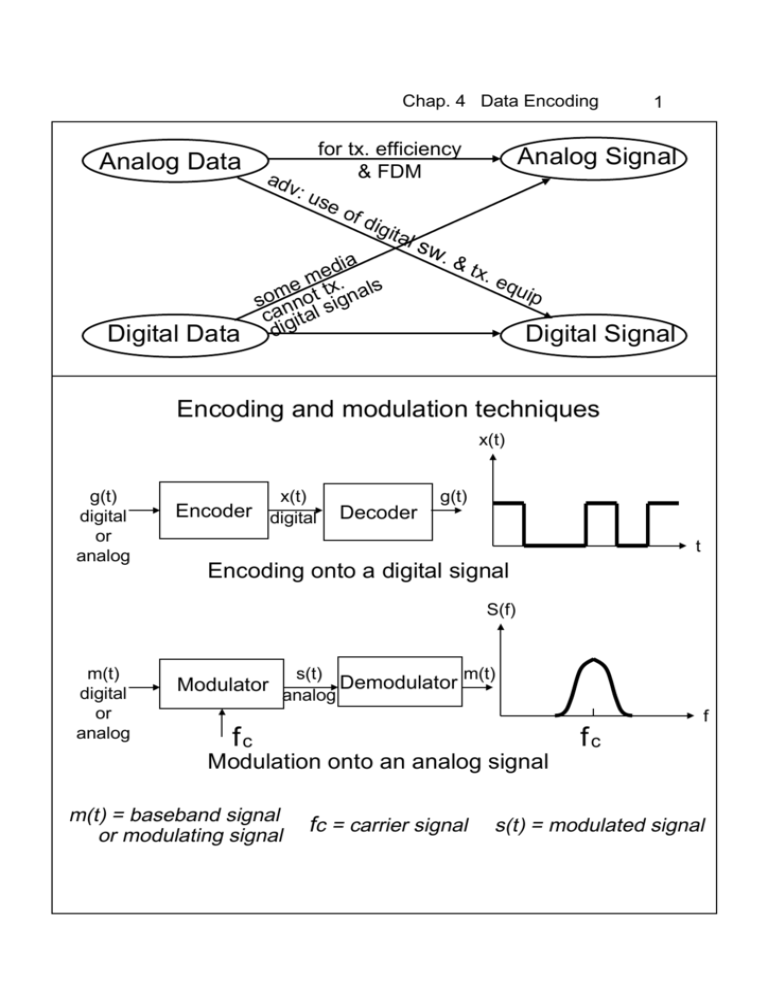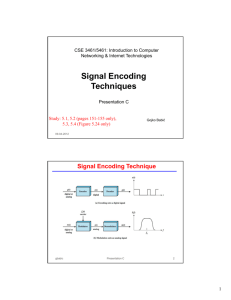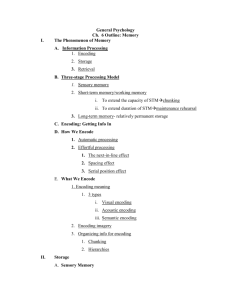Digital Data Digital Signal Analog Signal Analog Data Encoding and
advertisement

Chap. 4 Data Encoding Analog Data Digital Data adv : for tx. efficiency & FDM 1 Analog Signal use of d igit al s w. &t a i d x. e e m x. ls qui e t na m t p o o s nn sig ca gital di Digital Signal Encoding and modulation techniques x(t) g(t) digital or analog x(t) Encoder digital Decoder g(t) t Encoding onto a digital signal S(f) m(t) digital or analog Modulator s(t) m(t) Demodulator analog f fc fc Modulation onto an analog signal m(t) = baseband signal or modulating signal fc = carrier signal s(t) = modulated signal Chap. 4 Data Encoding 2 1. Digital Data ⇒ Digital Signals • A digital signal is a sequence of discrete, discontinuous voltage pulses. Each pulse is a signal element • Binary data are transmitted by encoding each data bit into signal elements • Encoding scheme: Mapping from data bits to signal elements • Key data transmission terms • Mark: binary digit 1; Space: binary digit 0 Chap. 4 Data Encoding 3 • Various encoding schemes • Evaluation factors – Signal spectrum: less bandwidth, no dc component, shape of spectrum (better to center in the middle of bandwidth) – Clocking: self-clocking capability is desired for synchronization – Error detection: better to have error-detection capability – Signal interference and noise immunity: – Cost and complexity: 1 0 • RZ (Return to Zero) 0 1 +V 0 -V – 0: positive pulse – 1: negative pulse – Signal returns to zero after each encoded bit • NRZ (Nonreturn to Zero) – Voltage level is constant during bit interval (no return to a zero voltage level) 1 0 0 1 – NRZ-L (NRZ Level) • 0: positive voltage • 1: negative voltage +V -V – NRZ-I (NRZ Inverted) • a form of differential encoding • 1: transition at the beginning of bit interval • 0: no transition Chap. 4 Data Encoding 4 – NRZ is simple, and efficiently use bandwidth – NRZ limitations • presence of dc component • lack of synchronization capability • Multilevel Binary – Bipolar-AMI (Alternate Mark Inversion) • • • • • • Three voltage levels (positive, zero, negative) 0: zero voltage 1: alternately by positive and negative voltages Better synchronization than NRZ no dc component error detection capability – Pseudoternary • Same as bipolar-AMI, except representation of 0 and 1 is interchanged • Biphase – Always a transition at the middle of each bit interval – Manchester • 0: high to low transition • 1: low to high transition – Differential Manchester • 0: transition at the beginning of bit interval • 1: no transition – Synchronization and error detection capability, and no dc component Chap. 4 Data Encoding Definition of digital signal encoding formats Nonreturn-to-Zero-Level (NRZ-L): 0 = high level, 1 = low level Nonreturn-to-Zero Inverted (NRZI): 0 = no transition at beginning of interval (one bit time), 1 = transition at beginning of interval Bipolar-AMI: 0 = no line signal, 1 = positive or negative level, alternating for successive ones Pseudoternary: 0 = positive or negative level, alternating for successive zeros, 1 = no line signal Manchester: 0 = transition from high to low in middle of interval 1 = transition from low to high in middle of interval Differential Manchester: Always a transition in middle of interval 0 = transition at beginning of interval 1 = no transition at beginning of interval B8ZS: Same as bipolar AMI, except that any string of eight zeros is replaced by a string with two code violations HDB3: Same as bipolar AMI, except that any string of four zeros is replaced by a string with one code violation 0 1 0 0 1 1 0 0 0 1 1 NRZ-L NRZI Bipolar-AMI Pseudoternary Manchester Differential manchester 5 Chap. 4 Data Encoding 6 • Modulation Rate – Data rate (expressed in bps) = modulation rate (or signaling rate or signal transition rate)(expressed in baud) times the number of bits per signal elemet Normalized signal transition rate of various encoding schemes Minimum NRZ-L NRZI Binary-AMI Pseudoternary Manchester Diff Manchester 0 (all 0’s or 1’s) 0 (all 0’s) 0 (all 0’s) 0 (all 1’s) 1.0 (1010…) 1.0 (all 1’s) 101010… 1.0 0.5 1.0 1.0 1.0 1.5 Maximum 1.0 1.0 (all 1’s) 1.0 1.0 2.0 (all 0’s or 1’s) 2.0 (all 0’s) Spectral density of various signal encoding schemes Chap. 4 Data Encoding 7 • Scrambling Techniques – For long-distance communications – No dc component, good synchronization and error detection capability, without reduction in data rate – B8ZS (Bipolar with 8-Zeros Substitution) • Based on bipolar-AMI • 8 consecutive zeros are encoded as either 000+-0-+ or 000-+0+-, s.t. two code violations always occur – HDB3 (High-Density Bipolar 3-Zeros) • 4 zeros are encoded as either 000-, 000+, +00+, or -00• Substitution rule is s.t. the 4th bit is always a code violation, and successive violations are of alternate polarity (not to introduce dc component) 1 1 0 0 0 0 0 0 0 0 1 1 0 0 0 0 0 1 0 Bipolar-AMI 0 0 0 V B 0 V B B8ZS 0 0 0 V B 0 0 V B 0 0 V HDB3 B = Valid bipolar signal, V = Bipolar violation Chap. 4 Data Encoding 8 Summary NRZ (NRZ-L, NRZI*) dc Comp.? BW Required Self-clocking? Error-detection? Application Multilevel Binary Biphase Scrambling (Bipolar AMI, (Manchester, (B8ZS, Pseudo ternary) Diff. Man.*) HDB3) Yes B No No B Yes, but ① No 2B Yes No -Simple -Digital mag. recording Yes Yes LAN No B Better than multilevel Yes Long dist. comm. * Differential encoding ① A long string of 0’s cause a problem in AMI A long string of 1’s cause a problem inPseudoternary 2. Digital Data ⇒ Analog Signals • Encoding is by modulation of a continuous sinusoidal carrier signal. This involves alteration of some characteristics of the carrier signal amplitude, frequency, or phase. • Various encoding techniques, ASK, FSK, PSK,... Chap. 4 Data Encoding ASK FSK Binary 1 A cos(2πfct + θc) A cos(2πf1t + θc) Binary 0 0 A cos(2πf2t + θc) 9 (Diff.) PSK A cos(2πfct + 180°) A cos(2πfct) (ASK) (FSK) (PSK) Chap. 4 Data Encoding • QPSK(Quadrature PSK) – Each signal element represents two bits Binary Binary Binary Binary 11: 10: 00: 01: cos(2πfct + 45°) cos(2πfct + 135°) cos(2πfct + 225°) cos(2πfct + 315°) • PSK using 12 angles and two amplitudes – 9,600 bps modem (2,400 baud x 4) • Those patterns showing legal combinations of amplitude and phase are called constellation patterns • 14,400 bps modem ⇒ 64 points constellation pattern • 28,800 bps modem ⇒ 128 points 10 Chap. 4 Data Encoding 11 3. Analog Data ⇒ Digital Signals • PCM (Pulse Code Modulation) – Based on the Nyquist’s Sampling Theorem: If a signal is periodically sampled at a rate ≥ twice the highest significant frequency component in the signal, then it can be reconstructed from the samples by using a low-pass filter Chap. 4 Data Encoding 12 Analog-to-digital conversion PAM sampler Analog input signal Quantizer PAM pulses PCM pulses Encoder output – Quantization noise: S/N = 6n + 1.8 dB, where n is # of bits used – To reduce quantization noise • large n or – Nonlinear coding – Companding Effect of nonlinear coding Chap. 4 Data Encoding 13 • DM (Delta Modulation) – Uses “n” = 1, I.e., binary digital signal is produced; “0” stands for change of -δ and “1” for change of + δ. – Higher sampling rate than PCM (Nyquist’s rate) is needed, but each sample uses only 1 bit instead of n. – Implementation much simpler than PCM. Chap. 4 Data Encoding 14 Delta Modulation Analog input + One time unit delay Binary input Binary output Comparator + One time unit delay 1 = +δ 0=-δ Transmission Reconstructed waveform Reception 4. AnalogData ⇒ Analog Signals • Motivation – Low frequency analog signals cannot be transmitted on unguided media. (would require antennas with km diameters) ⇒ higher frequency needed. – For FDM (Frequency Division Multiplexing) Chap. 4 Data Encoding 15 • AM (Amplitude Modulation) s(t) = [1 + m(t)]cos2 f c t Spectrum of an AM signal M(f) S(f) Discrete carrier term Lower sideband 0 B f Spectrum of modulating signal 0 fc-B Upper sideband fc Spectrum of AM signal with carrier at fc fc+B f DSBTC Chap. 4 Data Encoding • Angle Modulation (FM and PM) s(t) = Acos[2 f c t + φ (t)] – PM: φ(t) = npm(t) – FM: φ′(t) = nfm(t) 16 Chap. 4 Data Encoding 17 5. Spread Spectrum • Developed initially and popular for military and intelligence application • Spread the info signal over a wider bandwidth in order to make jamming and interception more difficult General model of spread spectrum digital communication system • Two types: – Frequency hopping and Direct sequence • Basis for CDMA (Code Division Multiple Access) Chap. 4 Data Encoding 18 • Frequency-Hopping – Signal is transmitted over a seemingly random series of frequencies, hopping from frequency to frequency at split-second intervals. – A receiver, hopping between frequencies in synchronization with the transmitter, picks up the message Chap. 4 Data Encoding 19 • Direct Sequence – Each bit in the original signal is represented by multiple bits (chip code) in the transmitted signal – The chipping code spreads the signal across a wider frequency band in direct proportion to the number of bits used Example of direct sequence spread spectrum







